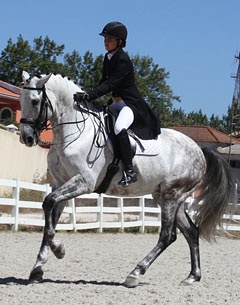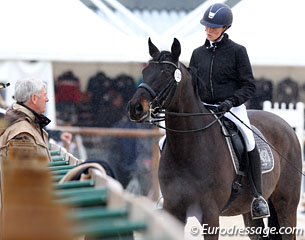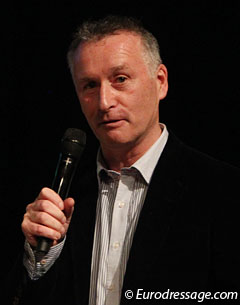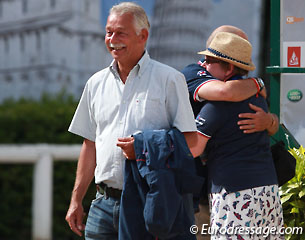
Finding the right trainer is extremely difficult, but once you’ve found that someone who clicks with you and your horse, what then do you as a rider need to do to keep them interested? You want your coach to stay passionate about you and your horse, and help you reach your goal whatever that may be. Whether it is to do a perfect preliminary test, or to win international Grand Prix, your trainer should be inspired by you to help you to get where you want to be, but the rider must play a part in fuelling this inspiration.
Of course you can throw money at the trainer, but every rider knows that the best trainers do it not only for the money! The first time I watched my coach Miguel leap across the arena on foot to show me how Batialo should do the half pass, I knew that I had found someone who was passionate about the sport. How then, does a rider keep that passion alive and make sure that the trainer applies his or her passion in each and every lesson?
When my mum was training me it was easy to tell if I was not inspiring her to give me the best instruction, because when I talked back or didn’t concentrate, she would just walk off and go home for a cup of tea! This is something that the poor instructor being paid for a lesson can’t, but sometimes wish they could.
My mum’s best pupil is a young girl, Casey, who comes just once a month but goes home and works on exactly what mum said. That is not to say that she does the same thing each and every ride, because a lesson should be used as a guide, not as a template for everyday. However, she takes in the information, thinks about it and comes back that one step better.
We all have things that we have to be told 100 times and no matter how much Miguel tells me to stick my tongue in, there it is again the next week, flopping away with my concentration. The important things, however, those that we need to take with us after each lesson, we must work on,and think about on and off the horse. A lesson doesn’t end in that 60 minutes, and the rider’s role is to put it in their mind and then think about it when they wake up, when they go for a walk, and when they saddle and unsaddle their horse.
 Thinking about our role as a rider I considered the German Training Scale for horses and how they must move up a series of levels to arrive at Grand Prix. So what would a rider training scale look like? What rider assets need to be present before a rider can move on to the next stage of training?
Thinking about our role as a rider I considered the German Training Scale for horses and how they must move up a series of levels to arrive at Grand Prix. So what would a rider training scale look like? What rider assets need to be present before a rider can move on to the next stage of training?
I set about asking some of the dressage world's most knowledgeable judges and riders about how they would rank the assets of a good horse and rider pair in terms of their ability to take in and improve on the aspects of dressage training. The following points were presented and the selected experts were asked to rank them from most important to least important: mental awareness, balance on the horse, physical strength, Body awareness, horse temperament-trainability, age of rider, and finally dedication or the amount of time they devote to riding.
German Olympian Ingrid Klimke felt that mental awareness on the horse was the most important element of the rider scale, followed by body awareness and then temperament and trainability of the horse. “This would then be followed by balance on the horse, physical strength, dedication, and finally rider age,” said Ingrid. “My ideal pupil would have great feeling for the horse, would be smart, ambitious, have good body fitness, be a hard worker and a positive thinker."
Well known trainer Jan Bemelmans felt that every point has its importance and the ideal student was not about their own assets, but more about the relationship you have with them. “You have to believe in your student,” says Jan. “I would add that hard work beats talent and a compassionate, talented worker would be the best pupil for me!”
British Olympian Richard Davidson was able to rank each asset, but felt he needed to clarify each in order to fully provide the best answer. “Mental awareness has got to come first as a rider's mental state governs what their physical (body) does/does not do,” Richard told Eurodressage. “It also governs their timing and choice of actions/aids. A rider's mental capacity also determines whether they are able to appreciate the psyche of how horses learn and react.”
Body awareness was next up on Richard’s list, because in order to get 'body control' a rider first has to have 'body awareness’. “Control comes secondary, and all riders need to keep refining their body awareness and control in order to make appropriate choices in the application and timing of their aids.”
 Balance on the horse came in third, as balance is made up of many key elements that are vital to dressage. “Balance on the horse is made up of body part control, body part adjustability, and also the rider’s ability to anticipate and have confidence in the horse's movements and dynamics. Understanding the psyche of the horse helps with this," he said.
Balance on the horse came in third, as balance is made up of many key elements that are vital to dressage. “Balance on the horse is made up of body part control, body part adjustability, and also the rider’s ability to anticipate and have confidence in the horse's movements and dynamics. Understanding the psyche of the horse helps with this," he said.
Dedication or amount of time devoted to riding Richard would replace with 'aptitude and commitment’, knowing some riders who, in spite of limited time due to other commitments, are able to learn more about themselves and their horses, than some others who devote their whole lives to horses but don't quite get how horses really behave and learn. “I spend a lot of time, when I'm not riding, thinking about how my horses are developing, what we should change, what we should keep the same, and so on - so it's not all about the time a rider spends actually riding.”
Physical strength Richard feels would be better as physical fitness, making the very valid point that sometimes smaller, less physically strong riders, can be fit in their body muscles and must ensure they train their horses to be light and responsive and possibly even question the type of horse that is most suitable for them. “So, to sum-up, I don't think strength is all-important but I do think fitness and a light training system is,” Richard added.
Feeling that the trainability and temperament of the horse is more a horse asset than that of his rider, Ricahrd felt that the age of the rider was irrelevant, recalling a fantastic Grand Prix test at the European Championships by someone well into their 80’s.
From an Olympic level judging perspective, British O-level judge Stephen Clarke, and Mexican O-level judge Maribel Alonso, both found that dedication and amount of time devoted to riding was the most important element to the rider training scale, followed by mental awareness.
“An ideal pupil is a rider who is open minded, doesn’t make excuses, and is prepared to work on the areas that need improving or developing” said Stephen. “It is helpful if they are intelligent and logical in their thinking, and vital that they have a natural empathy for the horse.”
 Clarke placed balance on the horse in third spot followed by body awareness. He says that physically riders need to be fit and with
sufficient core strength to enable them to sit independently in the saddle. “Obviously, natural balance and athleticism are a huge asset.”
Clarke placed balance on the horse in third spot followed by body awareness. He says that physically riders need to be fit and with
sufficient core strength to enable them to sit independently in the saddle. “Obviously, natural balance and athleticism are a huge asset.”
Maribel Alonso adds that even when a rider is far from being naturally talented, “practice makes perfect” and believes that if a rider dedicates time to riding, has mental awareness and therefore body awareness, his balance on the horse will improve, and he/she will be able to use the physical strength in a correct and productive way.
“With all these elements the rider will seek to achieve a better communication with the horse and most well trained horses will improve their temperament if the rider works with them and not against," said Alonso.
Believing that the age of the rider matters depending on how fit the rider is, Maribel thinks that the ideal pupil is the one that tries every day with an open mind, and is open to try different approaches and listen to his/her horse. “The one who does not think s/he knows it all, because everyday we learn something new and horses make great teachers. Patience is a key element, learn to wait, the horse needs time. A good pupil is the one that shows respect to himself and therefore to the horse so s/he never forgets to reward the horse. S/he must always be loving and caring putting the horse's welfare as number one. I am convinced that when strength takes over, dressage finishes. Training is never a straight line, it comes in waves, sometimes we are at the peak and sometimes at the bottom, so riders have to be ready to start everyday again and again.”
Hear Hear !
by Sarah Warne for Eurodressage
Photos © Marta Guedes Vaz - Astrid Appels/Eurodressage
Related Link
Sarah Warne's Classical Training Articles